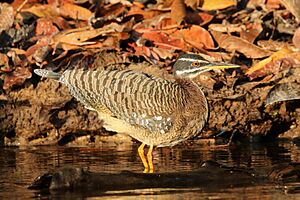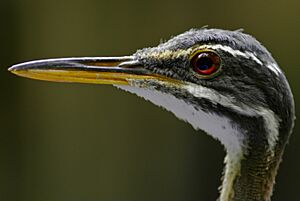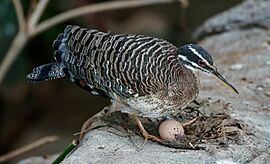Sunbittern facts for kids
Quick facts for kids Sunbittern |
|
|---|---|
 |
|
| on Cristalino River Southern Amazon, Brazil |
|
| Conservation status | |
| Scientific classification | |
| Genus: |
Eurypyga
|
| Species: |
helias
|
 |
|
| Sunbittern range | |
| Synonyms | |
|
|
The sunbittern (Eurypyga helias) is a unique bird found in the warm, tropical parts of the Americas. It looks a bit like a bittern, which is a type of heron. This bird is the only member of its special bird family, called Eurypygidae, and its genus Eurypyga.
Sunbitterns live in Central and South America. There are three different types, or subspecies, of sunbitterns. Scientists have found that sunbitterns are related to another interesting bird called the kagu. The kagu lives far away in New Caledonia. This connection suggests that both birds came from a very old supercontinent called Gondwana.
Contents
What is a Sunbittern?
The sunbittern is a special bird that scientists used to group with Gruiformes, which include cranes and rails. However, they always knew this might not be the perfect fit. The sunbittern is most similar to the kagu, another bird from the same group.
Studies of their DNA show that the kagu and sunbittern are very close relatives. They both have a unique way of showing off their wings. These two birds likely form their own ancient bird group. This group might also include some extinct birds and the mesites. Interestingly, both the kagu and mesites have special "powder down" feathers.
Types of Sunbitterns
The sunbittern was once thought to be two separate species. Now, scientists consider them one species with different types. These types are called subspecies. They look a bit different in their feathers and size. The three subspecies live in different areas and do not usually meet.
- E. h. helias (Pallas, 1781) – This is the Amazonian sunbittern.
- E. h. major Hartlaub, 1844 – This is the northern sunbittern.
- E. h. meridionalis Berlepsch & Stolzmann, 1902 – This is the foothill sunbittern.
Appearance and Features
Sunbitterns usually have quiet colors like black, grey, and brown. These colors help them blend in with their surroundings. But their wing feathers hide a secret! When they spread their wings, you can see bright "eyespots" in red, yellow, and black.
These amazing eyespots are used for a few reasons. Sunbitterns show them to other sunbitterns during courtship. They also use them to scare away animals that might try to eat them. Male and female sunbitterns look very similar. You can tell them apart by small differences in their throat and head feathers. Like some other birds, sunbitterns have special powder down feathers.
The sunbittern has a long, pointed beak that is black on top. Its back toe, called a hallux, is short, like those of shorebirds. Sunbitterns living in the lowlands east of the Andes mountains have mostly brown upper parts. Their legs and the lower part of their beak are orange-yellow. The other two subspecies are usually greyer. Their legs and beaks can sometimes be redder.
Where Sunbitterns Live
The sunbittern lives in a large area from Guatemala all the way to Brazil. The Amazonian sunbittern (E. h. helias) lives east of the Andes mountains. You can find it in the lowlands of tropical South America. This includes the Orinoco basin, the Amazon basin, and the Pantanal.
The foothill sunbittern (E. h. meridionalis) lives in a smaller area. It is found along the eastern slopes of the Andes in south-central Peru. It prefers lower subtropical areas, between 800 and 1,830 meters (2,600-6,000 feet) high.
The northern sunbittern (E. h. major) lives at different heights. Its range goes from southern Guatemala, through Central America, and into western Ecuador. This subspecies might also live in southern Mexico. It has been reported in Chiapas, but there are no recent records or specimens.
These birds prefer humid Neotropical forests. They like areas with open spaces under the trees. You will usually find them near rivers, streams, ponds, or lagoons.
Sunbittern Behavior
Sunbitterns are very good at hiding. They are hard to spot in the forest. When they feel threatened, they quickly open their large wings. This shows off the amazing eye-like patterns on their feathers. This sudden display can surprise and scare away predators.
What Sunbitterns Eat
Sunbitterns eat many different kinds of animals. Insects are a big part of their diet. They eat cockroaches, dragonfly larvae, flies, and water beetles. They also hunt other small creatures like crabs, spiders, and earthworms. Sometimes, they even catch small vertebrates. These include fish, tadpoles, frogs, eels, and lizards.
Some sunbitterns have been seen using a clever trick to catch food. They use baits or lures to attract prey closer to them. This is a type of tool use, which is rare in birds. So far, this behavior has only been seen in sunbitterns living in zoos.
Reproduction and Life Cycle
Sunbitterns begin building their nests at the start of the wet season. Before nesting, they perform special flight displays. They fly about 10 to 15 meters (33-49 feet) high in the forest canopy.
They build open nests in trees. The female sunbittern lays two eggs. These eggs have blotched markings on them. The young chicks are quite developed when they hatch. However, they stay in the nest for several weeks after they are born.
Images for kids
-
A sunbittern on display in the Natural History Museum, London.






